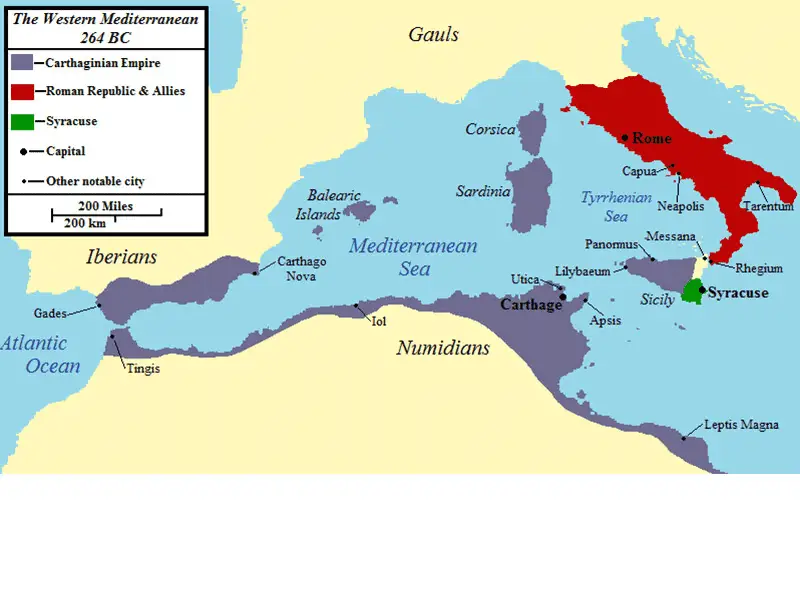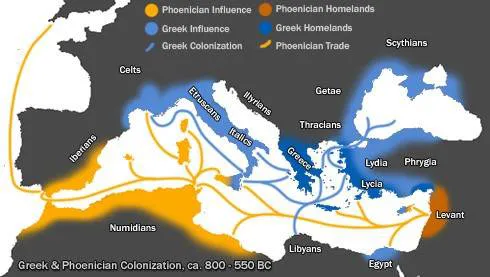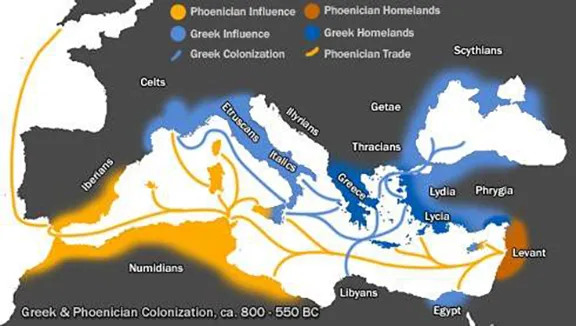The Carthaginians adopted a more warlike attitude than the Phoenicians and this was to prove decisive.
By Nick Nutter | Updated 6 Mar 2022 | Andalucia | History |
Login to add to YOUR Favourites or Read Later


Although from the same part of the world, the Lebanon, and, initially the same race of people, the Carthaginians developed a more forceful attitude than the Phoenicians. When faced with threats to their trading empire or settlements they took military action. Over time the Phoenicians seem to have split away from their countrymen of Carthage and the Carthaginians were able to take over Phoenician interests in Spain with no evidence of any force being used.


As we have seen the Phoenician trading posts set up in Andalucia between 850 and 800 BCE all experienced a period of expansion with new buildings, signs of a growing elite presence and increased trade between 700 and 600 BCE. At the same time, since 814 BCE, the Phoenicians had been expanding their influence along the north coast of Africa from what was to become their greatest city, Carthage.
Carthage was situated in a strategic position, about halfway between the eastern and western extremes of the Mediterranean Sea, commanding the 150-kilometre wide bottleneck between Africa and Sicily. Being in the central Mediterranean, the traders from Carthage were more aware of the threats to their trade network posed by, first the Greeks and then the Etruscans (ancient Italians who later became Romans). The Greeks founded their first colony at Naxos on Sicily in 735 BCE followed by Syracuse the following year and by 650 BCE Sicily, previously entirely within the Phoenician sphere, was divided into an eastern section, Greek, and western, Phoenician. The Greeks also held a strong position in Italy.
It is about 650 BCE that the traders of Carthage took their first action sanctioned by leaders from Carthage rather than Tyre. They colonised Ibiza, establishing a base between the Greeks on Sicily and the Iberian peninsula. It is from this point that Carthage can be considered a separate power. First, we need to look at how the Phoenicians had previously expanded their trading networks.
Up until this date, the various expeditions to the west had been sponsored by the city of Tyre, the merchant ships, crews, supplies, materials and initial trading products. (The other Phoenician cities as explained earlier, were occupied with trade in other directions). Once a settlement was established, and I have used the word settlement advisedly throughout (the Phoenicians had no pretensions to colonise a country), then the potential rewards flowing back to Tyre were huge. In the east Phoenician traders had become used to negotiating with indigenous rulers for the rights to establish a trading settlement, the rights, sometimes sole rights, to trade and the relative value of goods; a quantity of wine was worth a certain weight of silver for instance. Coinage was not introduced into the Phoenician trading system until about 450 BCE. This was all backed up by a state (Tyre) sponsored fleet of warships, biremes and the battleship of the Mediterranean, the trireme. Tyre had also been known to hire its fleet to allies during times of conflict, another lucrative source of income and another story.
The Phoenician expansion in the west is a slightly different story to that in the east and the central Mediterranean. The first voyages of exploration and settlement were sponsored by Tyre and, although no record now exists, we can expect the same settlement and trade terms to have been agreed with local rulers, including a guarantee of protection. It is easy to imagine that the traders became a valued asset of the local chieftain, almost a possession, a Golden Goose, purveyors of rare and exotic materials from the east that elevated the local ruler to a different level to that of his contemporaries inland. That is not to say that the Phoenicians were able to take advantage of an indigenous naiveté, particularly in Andalucia. Remember the locals had been trading with North Africa since at least 2500 BC and had been integrated into the Atlantic Bronze trade since about 1000 BC. The difference is distance. It was a long way to row from Tyre to Cadiz if there was trouble brewing and the distance from the home city, over time, gave the traders in the west a certain independence despite their allegiance to Tyre.
Fortunately, in the west, that is west of Sicily, there was not the almost constant threat of competing land orientated civilisations, at various times, Babylonians, Egyptians, Assyrians, Hittites and Persians, all vying for a share of the wealth, in the form of goods unattainable elsewhere, flowing from the Phoenician cities on the Lebanese coast that preoccupied the rulers of Tyre, Sidon, Byblos and the rest. In times of trouble, the rulers of those cities recalled their fleets and their mercenary armies leaving any of their settlements abroad without any prospect of protection if it were needed. In the west there was no danger from any great competing civilisations, tribal conflicts perhaps, but none of any great menace to the settlers who in many cases, certainly in the early years, felt no need to defend their settlements with strong walls or deep ditches, perhaps the local chief furnished all the defence required as part of the trading deal. Only as time passed and news of the wealth of the west filtered to competing traders, notably the Greeks, did any threats materialise and when they did they appeared from the sea, not the land.
It was only a matter of time before one of the western settlements became rich and powerful enough to build its own fleet, hire its own mercenary armies and gather the nerve to shelve their allegiance to their home city and, importantly, its gods, who had protected them thus far. The two likely contenders were Cadiz and Carthage.
History reveals that it was Carthage that bit the bullet. They used their wealth from trade to build a fleet of warships and adopted a much more militaristic attitude to those they considered a threat. From this point on it is probably more correct to use the word colony than settlement. The Carthaginians were determined to stay.
No longer were tributes paid to Tyre or Sidon, the Carthaginians appointed magistrates in the towns they colonised, including those previously considered Phoenician. The magistrates ruled the towns and answered directly to Carthage.
In 600 BCE the Greeks founded Massalia (Marseilles) and in 575 BCE Emporion in northeastern Spain. The first colonisation at least was opposed, unsuccessfully, by a Carthaginian fleet according to Thucydides's (Athenian historian 460 - 400 BCE). The Greeks were the first nation to challenge Carthaginian supremacy in the western Mediterranean but Carthaginian hegemony was not finished until the end of the Second Punic War against Rome in 202 BC.